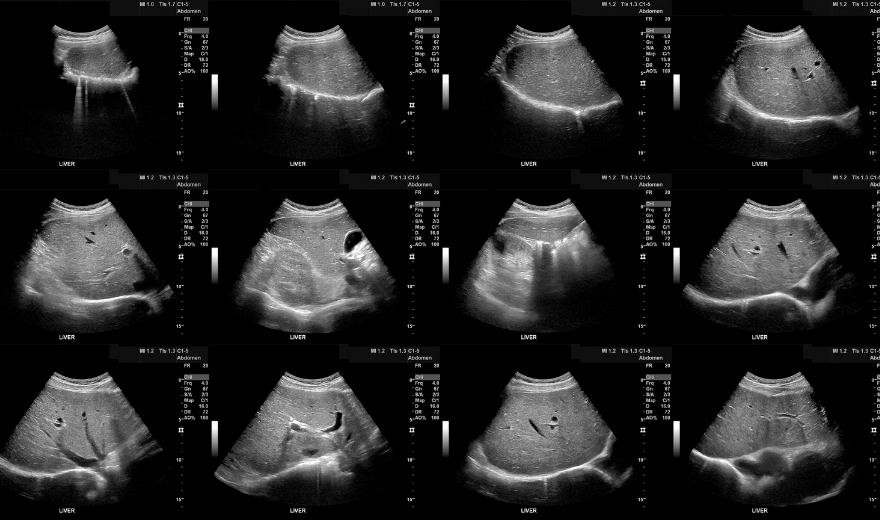
WHAT IS ABDOMINAL ULTRASOUND IMAGING?
Ultrasound imaging, also called ultrasound scanning or sonography, is a method of obtaining images of internal organs by sending high-frequency sound waves into the body. The reflected sound waves’ echoes are recorded and displayed as a real-time visual image. No ionizing radiation (x-ray) is involved in ultrasound imaging. An abdominal ultrasound image is a useful way of examining internal organs, including the liver, gallbladder, spleen, pancreas, kidneys, and bladder. Ultrasound images are captured in real time which can help to diagnose a variety of conditions and to assess damage caused by illness.
WHAT ARE SOME COMMON USES OF THE PROCEDURE?
Ultrasound imaging is used extensively for evaluating the kidneys, liver, gallbladder, pancreas, spleen, and blood vessels of the abdomen. Because it provides real-time images, it can also be used to:
-
Guide procedures such as needle biopsies, in which needles are used to sample cells from organs for laboratory testing.
-
Help a physician determine the source of many abdominal pains, such as stones in the gall bladder or kidney, or an inflamed appendix.
-
Help identify the cause for enlargement of an abdominal organ.
Doppler ultrasound is a special type of ultrasound study that examines major blood vessels. These images can help the physician to see and evaluate:
-
Blockages to blood flow, such as clots.
-
Build-up of plaque inside the vessel.
-
Congenital malformation.
With knowledge about the speed and volume of blood flow gained from an ultrasound image, the physician can often determine whether a patient is a good candidate for a procedure like angioplasty.
HOW SHOULD I PREPARE FOR THE PROCEDURE?
You should wear comfortable, loose-fitting clothing for your ultrasound exam.
Do not to eat or drink for 12 hours before your appointment.
Pelvic ultrasound – drink water.
HOW DOES THE PROCEDURE WORK?
Ultrasound imaging is based on the same principles involved in the sonar used by bats, ships at sea, and anglers with fish detectors. As a controlled sound bounces against objects, its echoing waves can be used to identify how far away the object is, how large it is, its shape and internal consistency (fluid, solid or mixed), and how uniform it is.
The ultrasound transducer functions as both a loudspeaker (to create the sounds) and a microphone (to record them). When the transducer is pressed against the skin, it directs a stream of inaudible, high-frequency sound waves into the body. As the sound waves echo from the body’s fluids and tissues, the sensitive microphone in the transducer records the strength and character of the reflected waves. With Doppler ultrasound the microphone captures and records tiny changes in the sound wave’s pitch and direction. These signature waves are instantly measured and displayed by a computer, which in turn creates a real-time picture on the monitor. The live images of the examination can be recorded on videotape or on disk. In addition, still frames of the moving picture are usually “frozen” to capture a series of images.
WHAT WILL I EXPERIENCE DURING THE PROCEDURE?
Ultrasound imaging of the abdomen is painless, fast, and easy. You will lie on your back on an examining table. The radiologist or sonographer will spread some warm gel on your skin and then press the transducer firmly against your body, moving it until the desired images are captured. There may be varying degrees of discomfort from pressure as the radiologist or sonographer guides the transducer over your abdomen, especially if you are required to have a full bladder. The examination usually takes less than 30 minutes.
WHAT ARE THE BENEFITS VS. RISKS?
Benefits
-
Ultrasound scanning is non-invasive (no needles or injections, in most cases) and is usually painless.
-
Ultrasound is widely available and easy to use.
-
Ultrasound imaging uses no ionizing radiation, and is the preferred image modality for diagnosis and monitoring of pregnant women and their unborn infants.
-
Ultrasound provides real-time imaging, making it a good tool for guiding minimally invasive procedures such as needle biopsies.
-
Ultrasound images can visualize structure, movement and live function in the body’s organs and blood vessels.
Risks
For standard diagnostic ultrasound there are no known harmful effects on humans
WHAT DOES THE EQUIPMENT LOOK LIKE?
Ultrasound scanners consist of a console containing a computer and electronics, a video display screen and a transducer that is used to scan the body. The transducer is a small, hand-held device about the size of a bar of soap, attached to the scanner by a cord. The radiologist or sonographer spreads a lubricating gel on the patient’s abdomen in the area being examined, and then presses the transducer firmly against the skin to obtain images.
The ultrasound image is immediately visible on a nearby screen that looks much like a computer or television monitor. The radiologist or sonographer watches this screen during an examination and captures representative images for storage. Often, the patient is able to see it as well.
HOW IS THE PROCEDURE PERFORMED?
The patient is positioned on an examination table and the gown or shirt is lifted to expose the abdomen, and a clear gel is applied to the abdomen to help the transducer make secure contact with the skin. The sound waves produced by the transducer cannot penetrate air, so the gel helps to eliminate air pockets between the transducer and the skin. The sonographer or radiologist then presses the transducer firmly against the skin and sweeps it back and forth to image the area of interest.
When the examination is complete, the patient may be asked to dress and wait while the ultrasound images are reviewed on a monitor. Often, though, the sonographer or radiologist is able to review the ultrasound images in real time as they are acquired, and the patient can be released immediately.
WHO INTERPRETS THE RESULTS AND HOW DO I GET THEM?
A radiologist (a physician experienced in ultrasound and other radiology examinations) will analyze the images and send a signed report with his or her interpretation to the patient’s referring physician. The patient receives ultrasound results from the referring physician who ordered the test results.
WHAT ARE THE LIMITATIONS OF ABDOMINAL ULTRASOUND IMAGING?
Ultrasound waves are reflected by air or gas; therefore ultrasound is not an ideal imaging technique for the bowel. Barium exams and CT scanning are the methods of choice for bowel-related problems in most cases.
Ultrasound waves do not pass through air; therefore an evaluation of the stomach, small intestine and large intestine may be limited. Intestinal gas may also prevent visualization of deeper structures, such as the pancreas and aorta. Patients suffering from obesity are more difficult to image—this is because tissue attenuates (weakens) the sound waves as they pass deeper into the body.
Ultrasound has difficulty penetrating bone and therefore can only see the outer surface of bony structures and not what lies within and beyond. For visualizing bone or internal structures of certain joints, waves do not reflect clearly from bone or air. For visualization of bone, other imaging modalities, such as MRI (magnetic resonance imaging) may be selected.
Preparation
ABDOMINAL ULTRASOUND
Ultrasound imaging, also called ultrasound scanning or sonography, is a method of obtaining images of internal organs by sending high-frequency sound waves into the body. The reflected sound waves’ echoes are recorded and displayed as a real-time visual image. No ionizing radiation (x-ray) is involved in ultrasound imaging. An abdominal ultrasound image is a useful way of examining internal organs, including the liver, gallbladder, spleen, pancreas, kidneys, and bladder. Ultrasound images are captured in real time which can help to diagnose a variety of conditions and to assess damage caused by illness.
ABDOMINAL ULTRASOUND PREPARATION
These instructions are IMPORTANT. Please follow them.
-
You should wear comfortable, loose-fitting clothing for your ultrasound exam.
-
Do not to eat or drink for 6 hours before your appointment.
-
Please let us know before your exam begins if you may be pregnant.
continue reading
Related Posts
Cancer screening is testing done on people who may be at risk of getting cancer, but who have no symptoms and generally feel fine.
Ultrasound imaging, also called ultrasound scanning or sonography, involves exposing part of the body to high-frequency sound waves to produce pictures of the inside of the body.
Ultrasound imaging of the scrotum is the primary imaging method used to evaluate disorders of the testicles and surrounding areas.



